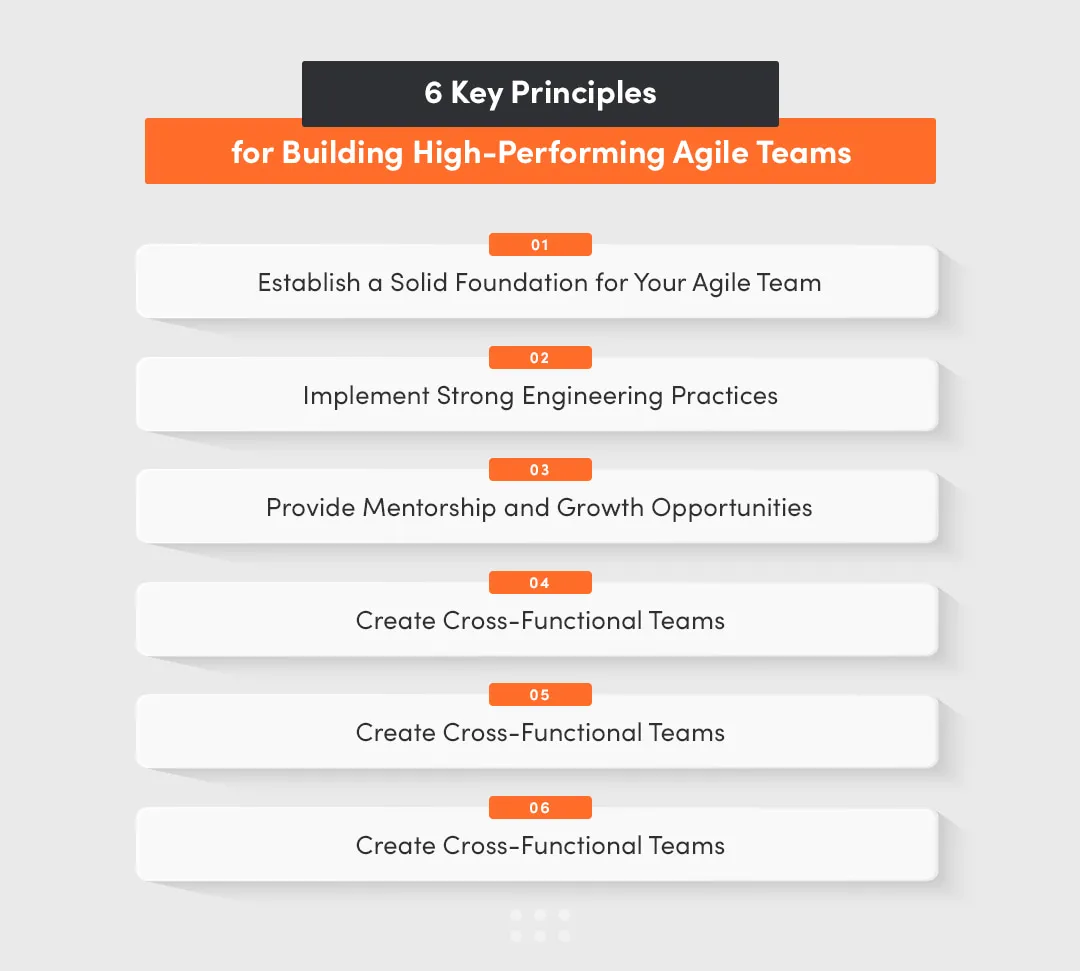Effective Agile team management is crucial for companies focused on innovation and fast value delivery to customers. Agile teams bring flexibility, efficiency, and the ability to adapt instantly to changing market conditions.
Imagine passionate, highly motivated individuals engaged in teamwork, directly contributing to your company's goals and delivering exceptional digital products.
What drives them to succeed? What are the secrets of outstanding teams?
In this article, we’ll discuss:
- 6 key principles for building high-performance Agile teams,
- Best practices to help you improve fully potential teams in 2024 and beyond.
- Main Characteristics of a Highly Performing Agile Team.
- What agile development team implementation will bring to your teams?
Why Adopt Agile?
Agile teams not only streamline project work but also build a culture based on collaboration, innovation, and trust. Agile has become a foundation for many tech companies because it enables faster, more efficient product delivery aligned with customer needs. Today, as more teams work remotely or in hybrid setups, Agile provides tools for effective remote work management and integrates diverse skills into a cohesive process.
Characteristics of High-Performing Agile Team

High-performing Agile teams stand out due to several key characteristics that enhance their efficiency and adaptability in a dynamic work environment.
Here are some defining traits of such teams:
- Autonomy and Self-Organization: High-performing Agile teams manage their work independently, setting priorities and selecting the best approaches for task completion.
- Trust-Based Collaboration: Open relationships among team members foster the exchange of ideas and information, which leads to better communication and more effective goal achievement.
- Focus on Continuous Improvement: Agile teams thrive in a culture of constant development, where team members learn from each other and continuously refine their skills.
- Strong Engineering Foundations: High-quality code and technical processes, such as test automation and continuous integration, allow the team to respond swiftly to changes and deliver valuable products.
- Clear Goals and Sense of Mission: Each team member understands how their work contributes to the larger project goals and the company's overall vision.
- Adaptability: Agile teams are prepared for change, enabling them to flexibly adjust to new challenges and priorities.
These characteristics bolster a team’s effectiveness and capacity to achieve ambitious project goals, making them an invaluable asset to a top agile team or any organization focused on growth.
Try our developers.
Free for 2 weeks.
No risk. Just results. Get a feel for our process, speed, and quality — work with our developers for a trial sprint and see why global companies choose Selleo.
6 Key Principles for Building High-Performing Agile Teams

Establish a Solid Foundation for Your Agile Team
Building a high-performance agile team starts with a solid foundation—values, goals, and principles that drive long-term success. Core Agile values, like trust, transparency, and accountability, foster an environment where the team can thrive and achieve results. In 2024, when teams are often geographically dispersed, shared values are especially crucial to ensure cohesion and integration.
Read also: 7 Agile Best Practices You Should Know
Our experience shows that team bonds and productivity improve when teams have clear collaboration guidelines and mutual trust. A successful Agile team should be self-organizing, with the autonomy to define its own work processes.
Practical Tip:
- Introduce regular team-building meetings, both formal and informal. Teams that have chances for informal conversations build better relationships and communicate more smoothly in projects.
Implement Strong Engineering Practices
Robust engineering foundations are essential for high-performing Agile teams. Practices like code reviews, continuous integration (CI), and continuous deployment (CD) enable rapid value delivery to customers without sacrificing product quality.
Modern Agile teams use AI-powered automation tools to speed up testing and deployment. These tools not only support developers but also help maintain high code quality, reducing the risk of technical debt.
Practical Example:
- At Selleo, we automated testing and deployment processes, increasing our product delivery speed by 20% compared to last year.
Provide Mentorship and Growth Opportunities
To enable team growth, each member should have the opportunity to learn and exchange knowledge with others. Pair programming, code reviews, and regular team meetings offer excellent occasions for sharing skills and professional development. Encourage team members to join mentoring sessions where everyone can share their experiences and learn from one another.
Remember, mentoring isn’t just for junior members learning from senior colleagues; every team member can learn from each other to unlock the team’s full potential and tackle diverse, complex tasks.
Practical Tip:
- Hold regular “Today I Learned” (TIL) sessions where team members share new skills or knowledge they gained from working on projects. This creates a space for continuous growth within the team.
How Do We Know This?
At our company, we love to recognize and reward people who never stop learning, growing, and helping others develop. We go above and beyond to provide our team members with everything they need to keep progressing, and we know that being supportive and sharing knowledge with colleagues are core values of high-performance teams. Team members feel empowered. This approach ensures that everyone feels valued and needed, making them more likely to be engaged in their work and willing to assist others.
Create Cross-Functional Teams
High-performance Agile teams are cross-functional, comprising people with diverse skills who can fully deliver on project backlogs. A team made up of developers, UX designers, and testers can efficiently complete tasks since it has all the necessary competencies.
Practical Example:
- A typical high-performing team at Selleo includes people with different specialities, all open to learning new skills. This allows the team to adapt dynamically to changes and make full use of its talents.
Communicate the Bigger Picture and Purpose
Team performance improves significantly when members understand how their work contributes to the bigger picture. Instead of simply picking individual tasks from the backlog without seeing their value, regularly discuss the project vision and remind the team of its mission.
Practical Tip:
- Hold regular “Today I Learned” (TIL) sessions where team members share new skills or knowledge they gained from working on projects. This creates a space for continuous growth within the team.
Shared team goals are crucial not only for fostering creativity and innovation but also for uniting people and encouraging them to communicate about challenges and outcomes.
In Agile, the concept of "feature teams" means that a team takes ownership of a specific area of the application but, with a solid understanding of the overarching purpose, feels responsible for the project as a whole.
Give the Team Decision-Making Autonomy
Exceptional agile teams achieve the best results when they have the freedom to make decisions, which enhances their engagement and creativity. Self-organizing teams with autonomy show higher motivation and are better equipped to tackle challenges.
Practical Tip:
- Our teams have full autonomy in setting up work processes and making project decisions, allowing them to adapt effectively to changing requirements. Give your team space to experiment—the results may surprise you!
Conclusion
In essence, these six elements are crucial for building Agile teams. Building high-performance Agile teams takes time and effort, but the results are worth it. The key is to integrate Agile values into daily practices and provide the team with tools and space for growth. A team with a clear purpose, strong engineering foundations, and decision-making freedom can deliver real value to clients while increasing its members’ satisfaction and engagement.
It’s also essential to foster a positive attitude among team members and encourage them to share knowledge and insights within the team. This fuel of productivity helps the team evolve continuously.
Key Agile skills include communication, collaboration, self-organization, and adaptability to change. Basic technical knowledge and familiarity with automation tools are also valuable.
Remote Agile team management requires regular sync meetings, clear communication guidelines, and tools for tracking progress and collaboration. Allowing space for informal chats can also support team integration.
Agile methods and principles enable flexible project management, increase customer satisfaction, and improve team efficiency. Agile is especially recommended for companies in dynamic environments or those frequently adapting their products to changing market needs.





